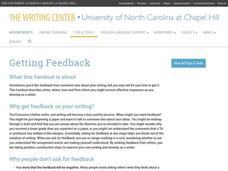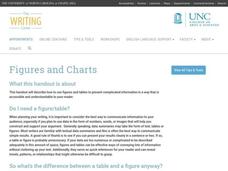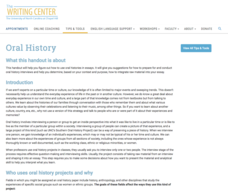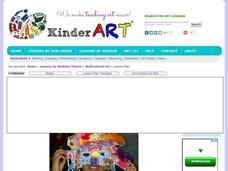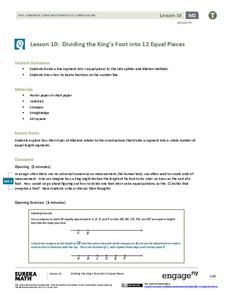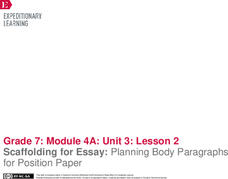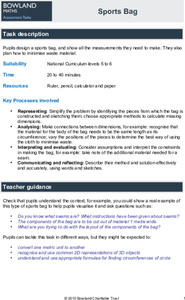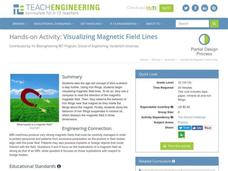101 Questions
Building Boxes
Build foundational knowledge of volume by building boxes. Given dimensions for a piece of grid paper, young mathematicians determine the number of possible open-top boxes it will make. As part of this task, they also find the box with...
University of North Carolina
Getting Feedback
As many writers know, you are your own worst editor. The 10th installment in the Writing the Paper series explains that getting feedback from others is crucial to the writing process. The handout highlights the best time to ask others to...
University of North Carolina
Figures and Charts
Sometimes words aren't the best way to get information across to the reader. The eighth handout in the 24-part Writing the Paper series describes different type of figures and charts to display complex information in a paper....
University of Miami
What is it? Weathering, Erosion, or Deposition?
Just as rocks move through the rock cycle, your giddy geologists will move descriptions around until they are all in the correct category. After cutting out several types of rock movement, learners determine whether the action is...
California Education Partners
Bud Not Buddy
A two-day assessment challenges scholars to read an excerpt from the story, Bud Not Buddy by Christopher Paul Curtis then complete a series of exercises in preparation for a writing assignment. Day one includes an independent...
California Education Partners
Seeing Eye to Eye
A performance task challenges scholars to read an informational text then respond with an explanatory essay. The exam begins with an independent reading of Seeing Eye to Eye by Leslie Hall. A second reading follows with the...
California Education Partners
Telescopes
An assessment challenges scholars to read an informative text then respond with an explanatory essay. The exam begins as participants read a text passage twice then take notes, making sure to jot down key details. Following the...
New York State Education Department
English Language Arts Examination: August 2017
Reading and comprehending a poem is a lot different than doing the same for a piece of fiction or an informational text. As part of a sample English language arts examination, readers put their skills to the test by reading passages in...
University of North Carolina
Oral History
There's no better way to learn something than to hear it straight from the horse's mouth. A handout on oral history, part of a larger series on specific writing assignments, explains how to conduct interviews and use the information...
Curated OER
How Thick Could It Get?
In this paper thickness learning exercise, students calculate how large a paper would get if you could fold it in half 50 times. Students complete 1 question.
Curated OER
Collage Butterflies
Students make their own butterfly on contact paper. In this art lesson, students cut or tear small pieces of tissue paper to put on their butterfly. Students place another piece of contact paper over the tissue paper pieces and cut the...
Curated OER
Sculpt-a-Planet
Learners study the moon and the planets. They create a painted, paper mache moon or planet sculpture.
Curated OER
Picking Up the Pieces and Putting them Back Together
Students examine how a breaking news story is constructed, first by predicting what facts and details must appear in what order, and then by assembling the story from cut-up pieces. They practice writing their own 'breaking news' lead...
Curated OER
Ripped Paper Art - Snowmen, Mountains and Evergreens
Students discover depth in photographs or paintings by creating a picture from scrap paper. For this art analysis lesson, students practice creating depth by placing different elements higher or lower on a picture. Students...
Curated OER
Paper Mache Masks
Students create masks using paper mache and a variety of '"found" objects.
EngageNY
Dividing the King’s Foot into 12 Equal Pieces
Apply, apply, apply! A measurement lesson applies a number of concepts to help learn a new construction. Scholars learn to divide a segment into n equal parts using a method that uses the Side Splitter Theorem and a method that...
101 Questions
Binder Clips: Large, Medium, Small
Ever wondered how many pieces of paper a binder clip can hold? Viewers of a short video are about to find out! Given measurement data for three different sized binder clips, learners must develop a method for figuring out how many pieces...
National Nanotechnology Infrastructure Network
Lines on Paper - Laser Box
See what you cannot see by getting a little creative. An intriguing lesson has learners use lasers to explore X-ray diffraction. Given a box with unknown structures, they shine a laser through the box and interpret the results....
University of North Carolina
Evidence
You can claim that soda rots people's teeth or that dinosaurs were actually birds, but your claim will not stand up if it is not backed by evidence. A handout from UNC Writing Center, the seventh in the Writing the Paper series of 24,...
EngageNY
Scaffolding for Essay: Planning Body Paragraphs for Position Paper
Let's make a plan. Scholars work on the plan for their papers using a Position Paper Planner. They talk with a partner about counterclaims and think about counterclaims to include in their papers. As learners begin to write, they work...
Reads Collab
Shamrock Necklace
Add a festive craft to a St. Patrick's Day celebration with a shamrock necklace. Scholars cut and color paper shamrocks and string colorful cereal to create a bright and cheery fashion piece.
Bowland
Sports Bag
Lay it out using the least amount of material. Learners use the dimensions of a cylindrical sports bag to find out the size of pieces of material needed to sew them. The pupils find the best placement of the pieces to use the least...
Teach Engineering
Visualizing Magnetic Field Lines
Magnetic fields might not be a field of dreams but they are useful. Class members observe the reactions of magnetic fields using a compass, iron filings in a paper container, and iron filings suspended in mineral oil.

